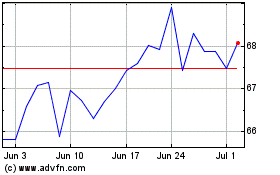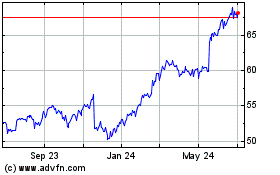Wal-Mart Cuts Outlook on Investments in Wages, E-Commerce -- 3rd Update
August 18 2015 - 12:34PM
Dow Jones News
By Sarah Nassauer
Wal-Mart Stores Inc. executives warned that profits will miss
their goals this year, an admission that the world's largest
retailer is spending heavily to generate even modest sales
growth.
On Tuesday, Wal-Mart said its quarterly profit fell 15% from a
year ago and the company lowered its earnings targets for the
current quarter and fiscal year. Wal-Mart cited higher costs from
adding store hours and raising hourly worker pay, as well as
currency fluctuations and more plebeian problems like store
theft.
Wal-Mart shares fell 3% in Tuesday trading to $69.78. The stock
has lost 19% of its value this year and now trades below
Amazon.com's market capitalization.
The spending has helped reverse a sales slump as Wal-Mart draws
more shoppers to its stores and customers spend slightly more when
they visit. Sales at U.S. stores open for at least a year increased
1.5% in the latest quarter, the fourth quarterly increase after a
long period of declines.
On Tuesday, the company said it would increase store hours
beyond a plan laid out in February and add more staff to speed
checkout lines and ensure shelves are better stocked. But those
changes, coupled with higher hourly wages, are now expected to
reduce its fiscal 2016 per-share earnings by 24 cents, compared
with an earlier 20-cent cost.
In April Wal-Mart raised the minimum hourly wage paid to
employees to $9 and said it would boost that to $10 for many
employees by February. In addition to higher wages, Wal-Mart's
profits are being squeezed by currency fluctuations and
lower-than-expected reimbursements for its pharmacy business. The
company on Tuesday also blamed an increased in shrink, or goods
that are stolen or lost in the chaos of a packed warehouse.
"These issues will present continuing profit challenges for the
remainder of the year. We are certainly disappointed. But we are
not standing still," said Greg Foran, chief executive of Wal-Mart
U.S. in a conference call. Wal-Mart U.S. accounts for around 60% of
the company's total sales.
Overall, second-quarter profit fell to $3.48 billion, or $1.08 a
share, in the quarter ended July 31, down from $4.09 billion, or
$1.26 a share, a year earlier. That was at the low-end of the
company's forecast for the second quarter. Total revenue was $120.2
billion, flat from a year earlier.
The company is now expecting fiscal year earnings of $4.40 to
$4.70 a share, down from its previous forecast for $4.70 to $5.05 a
share. For the current quarter, Wal-Mart forecast earnings of 93
cents to $1.05 a share.
During a prerecorded conference call, Wal-Mart CEO Doug McMillon
described the company as being in a "period of change," and finds
telling a 1996 magazine article hung in his Bentonville, Ark.,
office that asked, "Can Wal-Mart Get Back the Magic?"
Wal-Mart is in the midst of sweeping changes to its operations
in U.S. stores. It is beginning to change its inventory management
system so that employees can more often stock shelves from the
sales floor, not the backroom. And it is asking companies that sell
their products on Wal-Mart shelves to spend less on marketing and
more on lowering prices. In June it started mailing out around
10,000 contract renegotiation letters to suppliers, often asking
them to pay additional fees to warehouse products and other
measures.
The retailer has also revived its "shrink training program" for
employees, said Mr. Foran in the conference call. Last quarter
Wal-Mart said shrink was a "key urgent agenda item," already eating
into profits.
Some cost-cutting measures are likely coming. "For the back half
of the year we will manage these items closely with a continued
commitment to efficiency, cutting costs where appropriate, even in
a period of investment," said Mr. McMillon.
The results add to a string of mixed results from retailers in
recent weeks. Home Depot Inc. on Tuesday posted higher profit and
sales as homeowners spent on big-ticket items, but department store
retailers Macy's Inc. and Kohl's Corp. both reported tepid
second-quarter sales. U.S. consumer spending on items outside of
cars--such as clothes, furniture, building supplies and other
everyday items--rose 0.4% in July, the third consecutive month of
gains.
Despite its investments on its web business, Wal-Mart lowered
Tuesday its fiscal year forecast for growth of e-commerce sales. It
now expects a percentage increase in "the mid-to-high teens," down
from a previous prediction that sales would grow in the mid-20s
range. The weakness is driven by poor international performance,
especially in the U.K. and Brazil, said Neil Ashe, CEO of global
e-commerce for the retailer during a conference call. Global
e-commerce sales rose 16% in the second quarter, compared with 17%
in the first quarter of this year and 22% during the same period
last year.
Write to Sarah Nassauer at sarah.nassauer@wsj.com
Subscribe to WSJ: http://online.wsj.com?mod=djnwires
(END) Dow Jones Newswires
August 18, 2015 12:19 ET (16:19 GMT)
Copyright (c) 2015 Dow Jones & Company, Inc.
Walmart (NYSE:WMT)
Historical Stock Chart
From Mar 2024 to Apr 2024

Walmart (NYSE:WMT)
Historical Stock Chart
From Apr 2023 to Apr 2024
